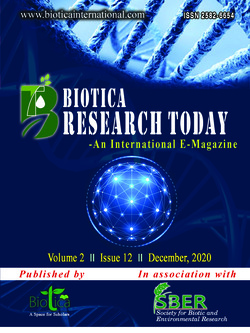
Progress and Prospect of Nanominerals in Livestock and Poultry Nutrition
Arun Kumar Singh*
Dept. of Animal Nutrition, College of Veterinary Science and Animal Husbandry, Anjora, Durg, Chhattisgarh (491 001), India
Sonali Prusty
Dept. of Animal Nutrition, College of Veterinary Science and Animal Husbandry, Anjora, Durg, Chhattisgarh (491 001), India
M. K. Gendley
Dept. of Animal Nutrition, College of Veterinary Science and Animal Husbandry, Anjora, Durg, Chhattisgarh (491 001), India
Piyush Thawkar
Dept. of Animal Nutrition, College of Veterinary Science and Animal Husbandry, Anjora, Durg, Chhattisgarh (491 001), India
Mukesh Sharma
Dept. of Animal Nutrition, College of Veterinary Science and Animal Husbandry, Anjora, Durg, Chhattisgarh (491 001), India
Ashutosh Choubey
Dept. of Animal Nutrition, College of Veterinary Science and Animal Husbandry, Anjora, Durg, Chhattisgarh (491 001), India
Kundan Krishnan
Dept. of Animal Nutrition, College of Veterinary Science and Animal Husbandry, Anjora, Durg, Chhattisgarh (491 001), India
Anupam Soni
Dept. of Livestock Production and Management, College of Veterinary Science and Animal Husbandry, Anjora, Durg, Chhattisgarh (491 001), India
DOI: NIL
Keywords: Antimicrobial, Nanoparticles, Production, Reproduction
Abstract
Minerals constitute a major role in production, reproduction and health of animals. Their deficiency or imbalances in diet lead to reduced growth and production. Nano minerals are mineral particles that exist in nano size (1-100 nm). Their action is attributed to their small size and increased surface area, thus leading to greater bioavailability. They are synthesized by physical, chemical or biological methods. Biological synthesis of Se nano-particle is gaining popularity due to its easily available source and less toxicity. Nano Zn particles could possibly reduce microbes generating methane in anaerobic fermentation. Thus, they reduced methane release and increased microbial biomass production. Sodium selenite nanoparticles were encapsulated by nano-precipitation for controlled release of Se nanoparticles. The release of selenium from nanoparticles was higher in acid (pH < 4), that caused better availability of the mineral in the small intestine.
Downloads
not found
Reference
Adegbeye MJ, Elghandour MM, Barbabosa-Pliego A, Monroy JC, Mellado M. (2019). Nanoparticles in equine nutrition: mechanism of action and application as feed additives. Journal of Equine Veterinary Science, 78(1): 29-37. doi: 10.1016/j.jevs.2019.04.001
Bąkowski M, Kiczorowska B, Samolińska W, Klebaniuk R. (2018). Silver and zinc nanoparticles in animal nutrition–a review. Annals of Animal Science, 18(4): 879-898. doi: 10.2478/ aoas-2018-0029.
Faisal S, Yusuf Hafeez F, Zafar Y, Majeed S, Leng X, 2019. A review on nanoparticles as boon for biogas producers—nano fuels and biosensing monitoring. Applied Sciences, 9(1): 59. doi: 10.3390/app9010059
